
20 minute read
BETTER BASICS: Delivery Done Right
EDITOR’S NOTE: Just as I was searching for someone to interview for a story about how to maintain the flavor and quality of restaurant food for delivery, I stumbled upon a March 30 article in the New York Times. One of the sources appeared to be the perfect person to contact: T.J. Steele—the executive chef/ owner of Michelin star-rated Claro in Brooklyn, New York and one of Starchefs’ 2019 Rising Stars. And perfect he was! Steele was more than willing to share his experience of launching food delivery in the midst of the pandemic— an experience that offers lessons I think every restaurateur can learn something from.
| BY KATHLEEN FURORE | There’s one fact that sets the stage for T.J. Steele’s pandemic-in spired tale of bringing delivery service to Claro: The restaurant was never , ever set up to deliver its award-winning Oaxacan cuisine to custom ers’ homes. As he told the New York Times, he’d always felt it just wasn’t wor th the effort.
But desperate times called for desperate measures, as they say—and when news came that New York City’s restaurants would go dark for inside dining on March 17, Steele sprang into action.
“W e listened to the news r eally carefully, and our core group decided right away that we would do whatever we were allowed to do to stay open,” recalls Steele, who admits it was a scary time for him and his staff.
As the r estaurant’ s website notes, “‘Claro’ means ‘clear’ in many different senses, but also means ‘of course’—a phrase that’s used
T.J. Steele in Oaxaca
DELIVERY Done Right MAINTAINING QUALITY AND FLAVOR DURING COVID AND BEYOND
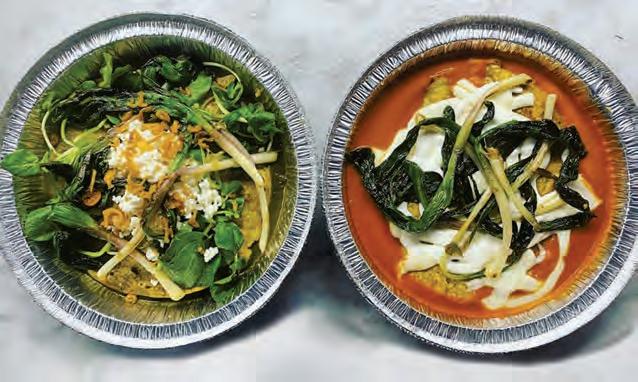
Claro’s enmoladas and entomatadas
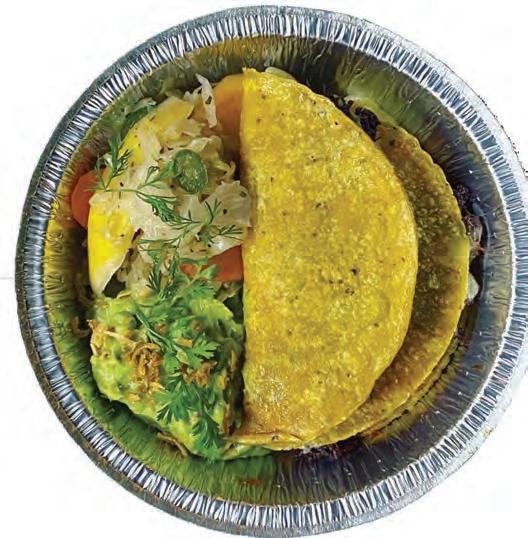
A new offering from Claro—chips and salsa to go
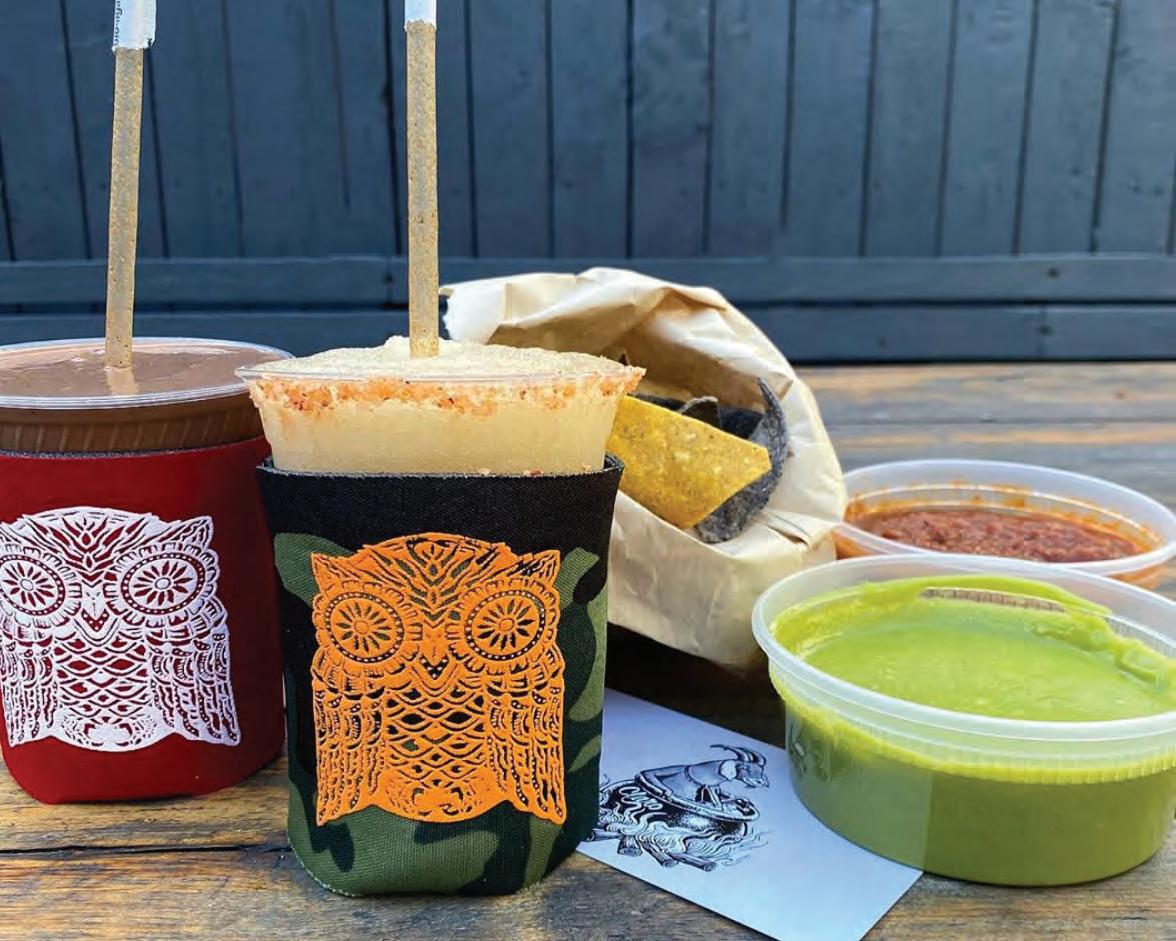
– CHEF T.J. STEELE
to put a person at ease.” It’s a fitting name for an establishment whose owner saw the situation so clearly and decided he would, of course, do whatever he could to keep business going.
CLARO PRE-PANDEMIC When Claro debuted in Brooklyn’s Gowanus neighborhood in August 2017, Grub Str eet, the popular food blog from New York Magazine, de scribed it as “Steele’s paean to the foods and people of Oaxaca.”
It was an apt description. Steele, after all, had lived part-time for many years in Oaxaca, where he cultivated relationships with craftsmen, artists, mezcaleros, cooks and farmers. The menu in cludes dishes made from the region’ s GMO heirloom (criollo) corn, and most everything on the menu—including the masa, cheeses, chorizo and moles—is made by hand. Meat and produce are organic and locally sourced when possible; and diners lucky enough to land a seat in the backyard patio can watch tortillas being pressed, and tlayudas, memelas and tosta das cooking on the woodfired comal.
Those hand-made dishes and the ingredients used to make them—so illustrative
Quesadilla de Barbacoa
of Steele’s dedication to his craft and his love for Oaxa ca—always have been at the heart of his vision for Claro. But when the pandemic hit, some things became impossible.
“W e knew we couldn’t keep doing the same things at the restaurant that we’d been do ing before,” Steele says.
THE TRANSFORMATION Though he’d never taken the time to craft a delivery menu, Steele undertook that task practically overnight, turn ing to his own experience of dining on deliver ed meals— something he’d done myriad times as a resident of New York City.
“I had a lot of experience of getting takeout at home and being pissed off at what I got—so I had to try to minimize that,” Steele says of his approach to creating a delivery menu full of food that would not only offer value but also “show up like
the customer wants it to.”
Steele admits the process of remaking the menu— which, as he remembers, started on Friday, March 13—has been a work in progress. There have been tweaks to both the dishes being offered and the pack aging it’s being delivered in—all made with the goal of making food that travels well, Steele says.
FINE-TUNING THE FOOD Every restaurant, of course, has to make decisions about what to offer on its deliver y menu based on many factors.
For Steele, tacos didn’t make the cut. “I think tacos are best when the tortilla is warm…and I see the time it takes for food to be deliv ered,” he says. “If a taco sits for almost an hour , it won’t represent the food or my restaurant in the way I want it to.”
Quesadillas are a differ ent story. “The fat in the cheese will absorb into the tor tillas and keep them mal leable—there are enough juices [in the contents of quesadillas] to pr event them from drying out,” says Steele.
Two of the top sellers are Claro’s takeout version of en tomatadas and enmoladas. The enmoladas, Steele says, “felt like a [Mexican version] of a to-go lasagna.” Even ceviche made the menu. “It’s one of my favorite things!” says Steele. “I was hesitant at first about having raw fish [for delivery]…but we keep it in separate bags away from the hot food. It’s gone over really well.” (For more about ceviche, see the story that starts on page 14.)
Tweaking recipes was also a key step in making some dishes more deliveryfriendly.
The seared duck breast in mole negro is one example. Steele switched the protein to a braised short rib. “A duck breast would arrive cold and dry and would be ruined if it was reheated in a microwave,” Steele explains.
PERFECTING THE PACKAGING Adjusting recipes for delivery is just the first step in making dishes more deliverable. Packaging is the second (and perhaps equally important) part of the equation. If the sauce has dried out and the cheese has hardened or slid off the top of the enchilada a hungry customer had been craving, all the work put into the preparation won’t matter—the dried out enchilada is what that customer will remember the next time he or she is choosing a restaurant for their next takeout meal.
Top Mexican restaurants make their own tortillas,and they know the best tortillas come from the best corn. Rovey Seed Co. is known across the country for providing the best quality non-gmo and organic white, yellow, blue, and red corn for tortillas and chips, as well as food grade lime, and other ingredients.
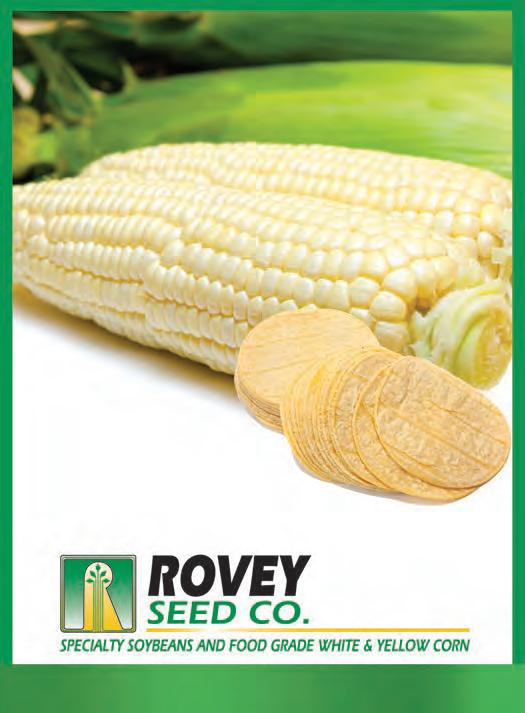
WWW.ROVEYSEED.COM • (217) 227-4541 WWW.ROVEYSEED.COM • (217) 227-4541

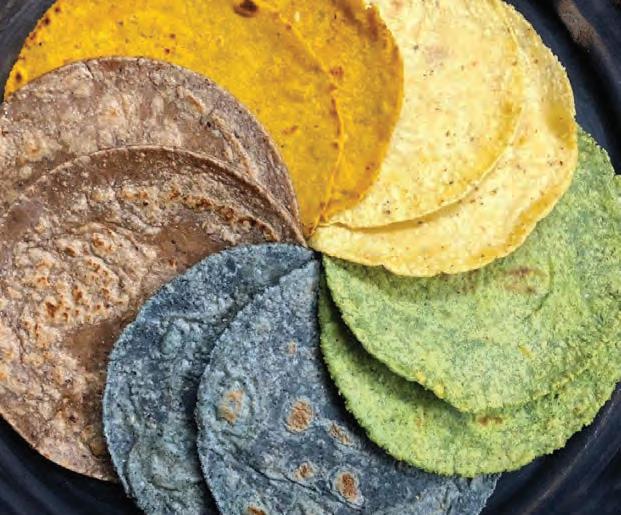
Tortillas made from criollo corn
– CHEF T.J. STEELE
As experienced a chef as Steele is, even he struggled with the optimal way to pack age Claro’s meals to go. He turned to foil containers that could be popped right into a customer’ s oven if they needed to heat the dish once it ar rived. “The dishes don’t have to be removed fr om the container to be heated,” he says.
Listening to customers’ r e

quests for “gr een” packaging, he switched to all sustainable containers. Some fell shor t. “They definitely cost more money, and some we tried were not very good—for ex ample, the moles would soak thr ough,” says Steele.
WHAT LIES AHEAD Delivery has been instrumental in keeping Claro afloat in the
past several months filled with unprecented challenges. But as important as it has been, Steele doesn’t think he will continue with delivery in its current form once things return to normal. ”We did it to support our community, keep our doors open and support our employ ees,” Steele says. “Mexican food has a stigma of what it is worth price-wise and we went above and beyond because we were conscious of how people were suffering.” But delivery platforms take such a big chunk of profits that Steele says the business was “cycling money through the bank but not really making that much.”
Steele will, however, keep some aspects of the delivery program he sped to create.
Take his homemade chips. “I never would allow chips at the r estaurant—we had tostadas and that was as far as I went with that,” he says. But he’s been making chips (which he mills and grinds the corn to make, just as he does for every dish he makes with masa) and selling them along with salsa via delivery; those will stay on the delivery menu.
Another addition that won’t disappear: the bags of masa Claro has been offering by the pound for customers who want to make their own tortillas. “If we sell 10 pounds a day we feel like champions—it’s more a fun thing, but we maybe make a little money off of it, too,” he says.
What the future holds for the restaurant industry as the coronavirus ebbs and flows is anybody’s guess. But whatever happens, delivery likely will remain an important piece of the puzzle for many Mexican and Latin restaurants—which makes it imperative for opera
Masa—now available by the pound
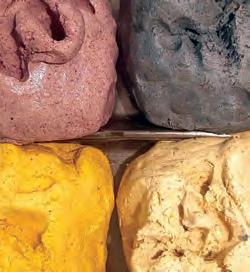
tors and chefs to do all they can to optimize their delivery menus in ways that maintain the quality and flavor of the food being delivered during COVID and beyond.
Kathleen Furore is the editor of el Restaurante.
VEGETABLE & CHEESE SHREDDER
HIGH VOLUME MEAT CUTTER
neHUB COLLECTION









MEAT TENDERIZER
MEAT CUTTER
JERKY SLICER MEAT GRINDER
Votar es la forma más poderosa que tiene la gente para expresar sus opiniones en los Estados Unidos. Al votar por candidatos en los que cree y en cuestiones que le interesan, puede lograr un impacto en cómo se gobierna nuestro país. Las próximas elecciones determinarán quién dirigirá Estados Unidos en los siguientes años y qué cuestiones recibirán atención. Asegúrese de que está registrado para votar e invite también a sus amigos, familia y empleados a registrarse. Para consultar información sobre cómo registrarse, visite gobierno.usa.gov/requisitos-inscripcion-votar
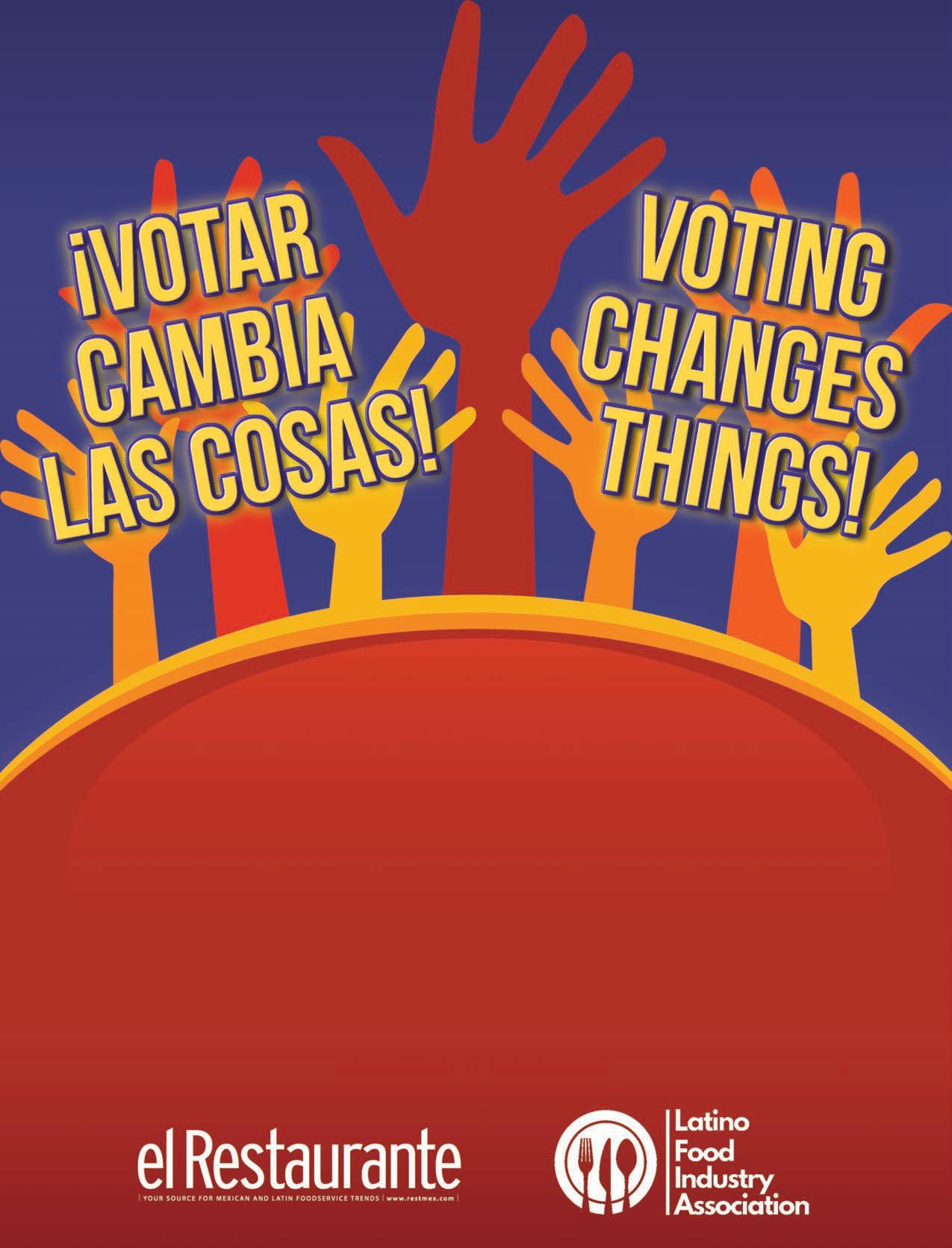
Este anuncio está patrocinado por la revista el Restaurante y la Latino Food Industry Association.
Voting is the most powerful way for people to express their opinions in the United States. By voting for candidates you believe in and issues you care about, you can impact how our country runs.The upcoming elections will determine who leads America in the coming years, and which issues get attention. Make sure you are registered to vote, and encourage your friends, family, and employees to register, too. For information about how to register, visit www.usa.gov/register-to-vote
This advertisement is sponsored by el Restaurante magazine and the Latino Food Industry Association.
NOTA DEL EDITOR: Justo cuando estaba buscando a alguien a quien entrevistar para tener una historia sobre cómo mantener el sabor y la calidad de la comida de un restaurante para las entregas, me topé con un artículo del 30 de marzo en el New York Times. Una de las fuentes parecía ser la persona ideal a quien contactar: T. J. Steele, el chef ejecutivo y propietario de Claro, que cuenta con una estrella Michelin, en Brooklyn, Nueva York, y quien fue nombrado una de las estrellas en ascenso de Starchefs en 2019. ¡Y, en efecto, era ideal! Steele estaba más que dispuesto a compartir su experiencia de emprender la entrega de alimentos en medio de la pandemia, una experiencia que ofrece lecciones de las que creo que todo restaurantero puede aprender algo.
| POR KATHLEEN FURORE | Hay un hecho que provee el contexto para la historia motivada por la pandemia de T. J. Steele sobre incorporar el servicio de entrega a Claro: el restaurante nunca fue diseñado para entregar su galar donada cocina oaxaqueña a los hogares de los clientes. Como le comentó al New Y ork Times, siempre había considerado que no valía la pena el esfuerzo.
Pero los tiempos apremiantes exigían medi das desesperadas, como suelen decir, y cuando llegaron las noticias de que los r estaurantes de la Ciudad de Nueva York cesarían el servicio para comer dentro el 17 de marzo, Steele entró en acción.
“Prestamos mucha atención a las noticias, y nuestro grupo principal decidió de inmediato que haríamos todo lo que tuviéramos permitido hacer para permanecer abiertos”, recuerda Steele, quien admite que fue un momento ater

T.J. Steele en Oaxaca
ENTREGAS bien hechas MANTENER LA CALIDAD Y EL SABOR DURANTE EL COVID Y LO QUE LE SIGA

Enmoladas and entomatadas de Claro
Nuevo de Claro: chips y salsa

– CHEF T.J. STEELE
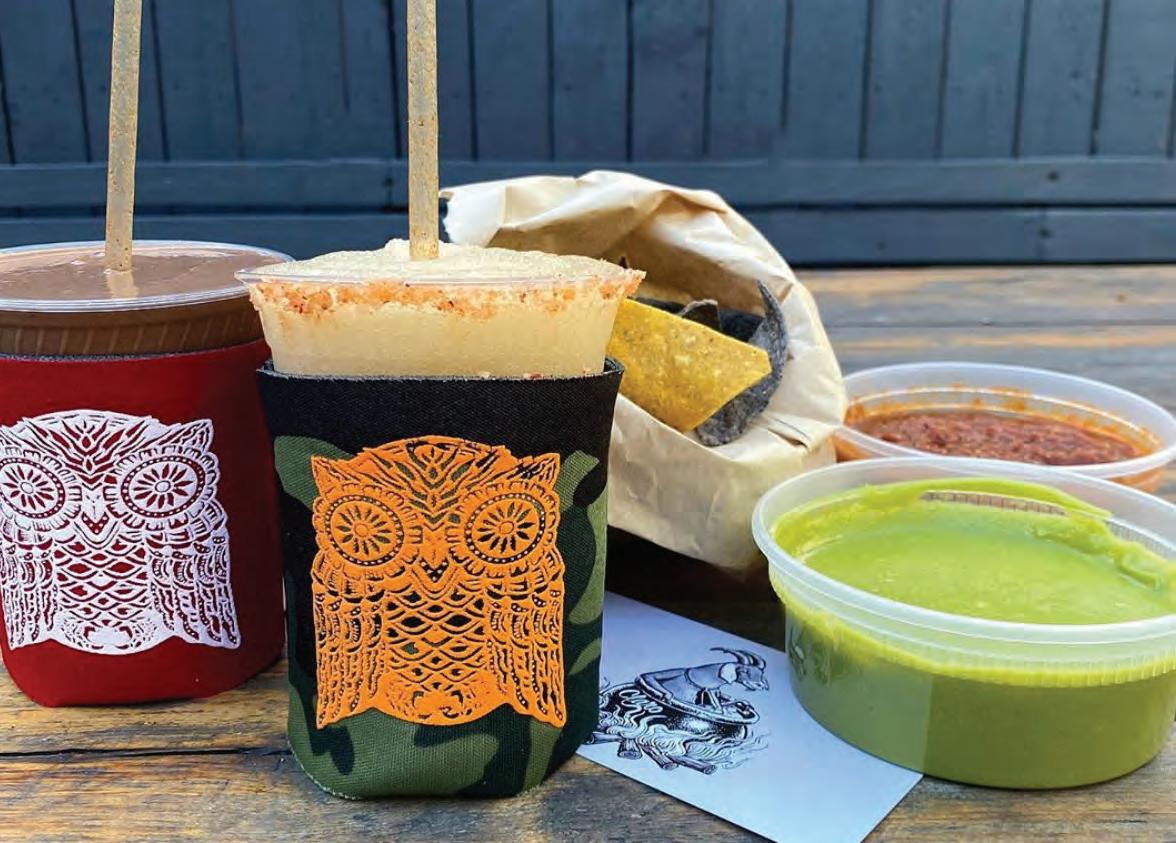
rador para él y su personal.
Como lo señala el sitio web del restaurante: “‘Claro’ significa ‘claro’ en muchos sentidos diferentes, pero tam bién significa ‘por supuesto’, una frase que se usa para tranquilizar a una persona”. Es un nombre apropiado para un establecimiento cuyo propietario vio la situación tan claramente y decidió que, por supuesto, haría todo lo posible para mantener el negocio andando.
CLARO ANTES DE LA PANDEMIA Cuando Claro hizo su debut en el barrio Gowanus de Brooklyn en agosto del 2017, Grub Street, el popular blog de comida de la revista New York, lo describió como “el himno de Steele a la comida y la gente de Oaxaca”.
Era una descripción adec uada. Steele, después de todo, había vivido a ratos durante muchos años en Oaxaca, donde forjó relaciones con ar tesanos, artistas, mezcale ros, cocineros y ganaderos. El menú incluye platillos elaborados con maíz criollo transgénico de la región, y casi todo lo que hay en el menú, incluyendo la masa, los quesos, el chorizo y los moles, está hecho a mano. La car ne y los pr oductos agrícolas son orgánicos y de origen local siempr e que es posible, y los comensales que tienen la suer te de sentarse en el patio trasero pueden ver cómo se prensan las tortillas y cómo se preparan las tlayu das, memelas y tostadas en el
Quesadilla de Barbacoa
comal de leña.
Dichos platillos hechos a mano y los ingr edientes empleados para hacerlos, tan representativos de la dedi cación de Steele a su oficio y de su amor por Oaxaca, siempre han estado en el centro de su enfoque para Clar o. Per o, cuando llegó la pandemia, algunas cosas se volvieron imposibles.
“Sabíamos que no podíamos seguir haciendo lo mismo que habíamos hecho antes en el restaurante”, dice Steele.
LA TRANSFORMACIÓN Aunque nunca se había tomado el tiempo para elaborar un menú para entregas, Steele emprendió esa tarea prácti camente de la noche a la mañana, recurriendo a su propia experiencia al comer comidas que son entr egadas, algo que había hecho innumerables veces siendo residente de la Ciudad de Nueva York.
“Tenía mucha experien cia en llevar comida a casa
y enojarme por lo que me habían dado, así que tuve que tratar de minimizar eso”, co menta Steele sobre su enfoque para elaborar un menú para entr egas lleno de comida que no solo ofrezca un valor, sino también “que sea como el cliente lo quiere”.
Steele admite que el proce so de rehacer el menú, el cual, según lo recuer da, comenzó el viernes 13 de marzo, ha sido una labor constante. Steele dice que ha habido ajustes tanto en los platillos que se ofrecen como en los empaques en los que se entregan, todo con el propósito de preparar alimentos que pueda ser trans portado adecuadamente.
ADAPTAR LA COMIDA Cada restaurante, por supuesto, tiene que tomar decisiones sobre qué ofr ecer en su menú de entregas en función de muchos factores.
Para Steele, los tacos no pasaron la prueba. “Creo que los tacos son mejores cuando la tortilla está caliente... y soy consciente del tiempo que lleva entregar la comida”, comenta. “Si un taco se enfría durante casi una hora, no representará la comida o mi restaurante de la manera que yo quiero”.
El caso de las quesadillas es otra historia. “La grasa en el queso se absorberá en las tortillas y las mantendrá maleables; hay suficientes jugos [en el contenido de las quesadillas] como para evitar que se sequen”, afirma Steele.
Dos de los platillos más vendidos son las versiones para llevar de Claro de sus entomatadas y enmoladas. Las enmoladas, dice Steele, “dan la impresión de ser una [versión mexicana de] lasaña para llevar”.
Incluso el ceviche está en el menú. “¡Es uno de mis favori tos!”, dice Steele. “Al principio tenía mis dudas sobre el pescado cr udo [para entregar]... per o lo mantenemos en bolsas separadas lejos de la comida caliente. Le ha ido bastante bien”. (Para saber más sobre el ceviche, eche un vistazo a nuestra historia en portada que comienza en la página 14).
Adaptar las recetas también fue un paso clave para lograr que algunos platillos fueran más fáciles de entregar.
La pechuga dorada de pato en mole negro es un ejemplo. Steele cambió la proteína a una costilla corta cocida. “Una pechuga de pato llegaría fría y seca, y se arruinaría al ser re calentada en un microondas”, explica Steele.
PERFECCIONANDO EL EMPAQUE Adaptar las recetas para las entregas es solo el primer paso para conseguir que los platillos se entreguen mejor. El empaque es el segundo (y, quizás, igualmente impor tante) en la ecuación. Si la salsa se ha secado y el queso se ha endur ecido o escurrido de la parte superior de la enchilada que se le había anto jado a un cliente hambriento, todo el trabajo realizado en la preparación no importará: la enchilada seca es lo que ese cliente recordará la próxima vez que elija un restaurante para su próxima comida para llevar.
A pesar de ser un chef con tanta experiencia, incluso Steele batalló con la manera óptima de empacar las comidas de Claro para llevar. Recurrió a recipientes de alu minio que pueden introducirse directamente en el hor no de un cliente si necesitara calentar la comida una vez que llegara. “No es necesario sacar la comida del recipiente para calentarla”, comenta.
Haciendo caso a que los cli entes pedían envases “ecológicos”, cambió por completo a contenedor es sustentables. Algunos no cumplier on las expectativas. “Definitivamente cuestan más dinero, y algunos que probamos no eran muy buenos, por ejemplo, los moles los atravesaban”, dice Steele.
LO QUE DEPARA EL FUTURO Las entregas han sido esenciales para mantener a Claro a flote en los últimos meses repletos de dificultades sin pr ecedentes. Pero, a pesar de

– CHEF T.J. STEELE
lo importantes que han sido las entregas, Steele no cree que continuará con ellas en su forma actual una vez que las cosas vuelvan a la normalidad.
“Lo hicimos para apoyar a nuestra comunidad, para mantener nuestras puertas abiertas y apoyar a nuestros empleados”, afirma Steele. “La comida mexicana tiene un estigma sobre lo que vale la pena en cuestión de precios, y fuimos un paso más allá porque éramos conscientes de cómo se vio afectada la gente”. Pero las plataformas de entrega to man una porción tan grande de las ganancias que Steele afir ma que el negocio estaba “haci
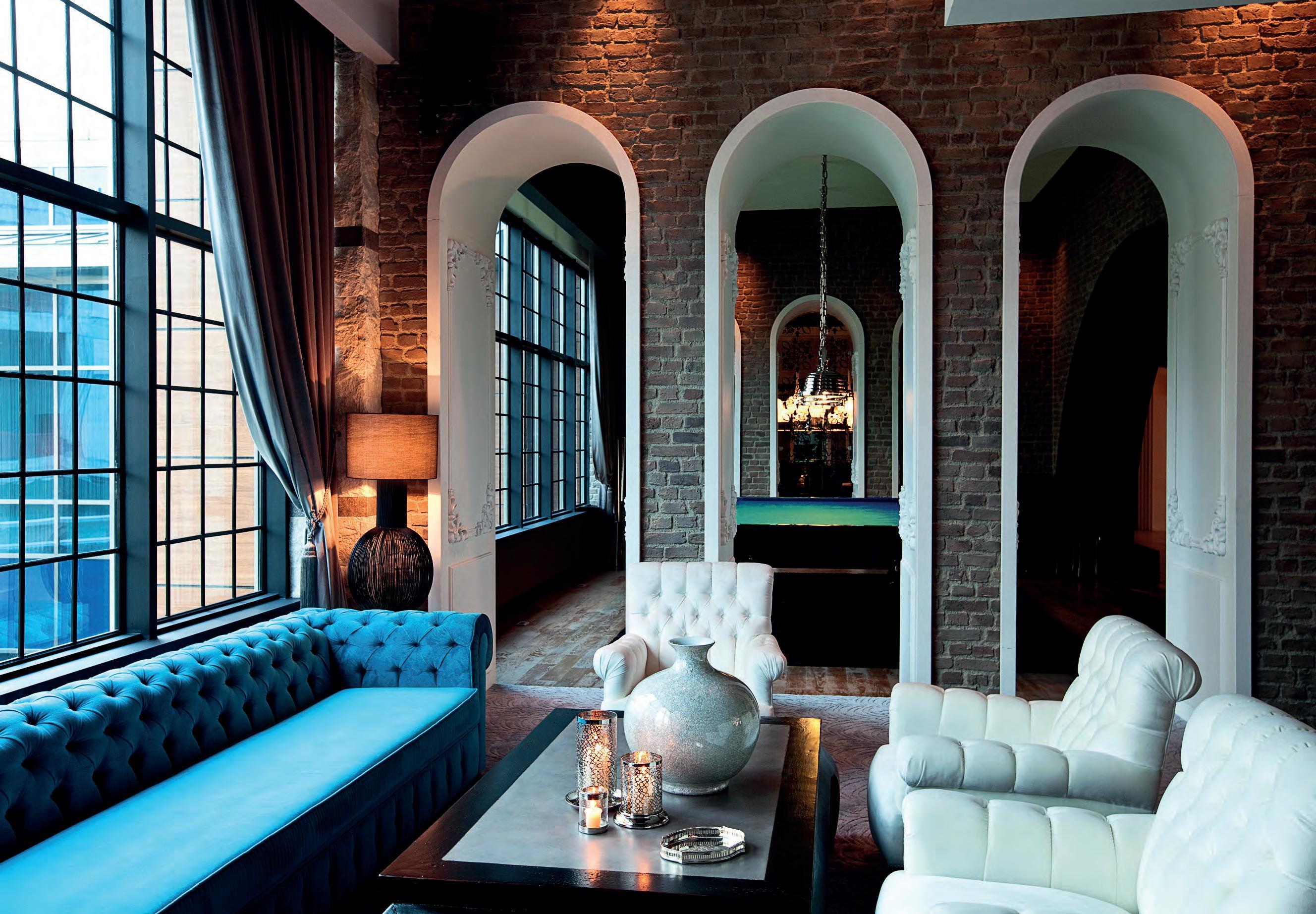
endo fluir diner o en el banco, per o r ealmente no se estaba ganando mucho”.
Steele, sin embargo, con servará algunos elementos del pr ograma de entr egas que se apresuró a diseñar.
Lleva sus papas fritas caseras. “Nunca permitiría papas fritas en el restaurante; teníamos tostadas, y eso ya era demasiado para mí”, comenta. Pero ha estado pre parando papas fritas (para las que muele y machaca el maíz para prepararlas, al igual que lo hace para todo platillo que elabora con masa) y las vende junto con salsa por medio de entregas; esas se quedarán en el menú de entregas.
Otra incorporación que no se irá: las bolsas de masa que Claro ha estado ofreciendo por libra a los clientes que desean hacer sus propias tortillas. “Si vendemos 10 libras al día, nos sentimos como campeones; es más cuestión de gusto, pero quizás también ganemos un poco de dinero”, dice.
Lo que depara el futuro para la industria restaurantera a medida que el coronavirus se dispara y disminuye es una in cógnita. Pero, pase lo que pase, las entr egas pr obablemente seguirán siendo una pieza clave del rompecabezas para muchos restaurantes mexicanos y
Masa
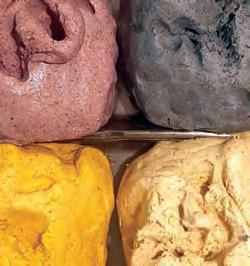
latinos, lo que obliga a los operadores y chefs a hacer todo lo posible para optimizar sus menús de entregas de manera que conser ven la calidad y el sabor de la comida a ser en tregada durante el COVID y lo que venga después.
Kathleen Furore es la editora de el Restaurante.
An Association for You!

The Latino Food Industry Association is a new organization designed specifically for you! The members are owners of Hispanic restaurants, grocery stores, suppliers, and other organizations involved in the food industry. The LFIA offers a wide range of benefits to members, ranging from marketing assistance to technology services to advocacy.
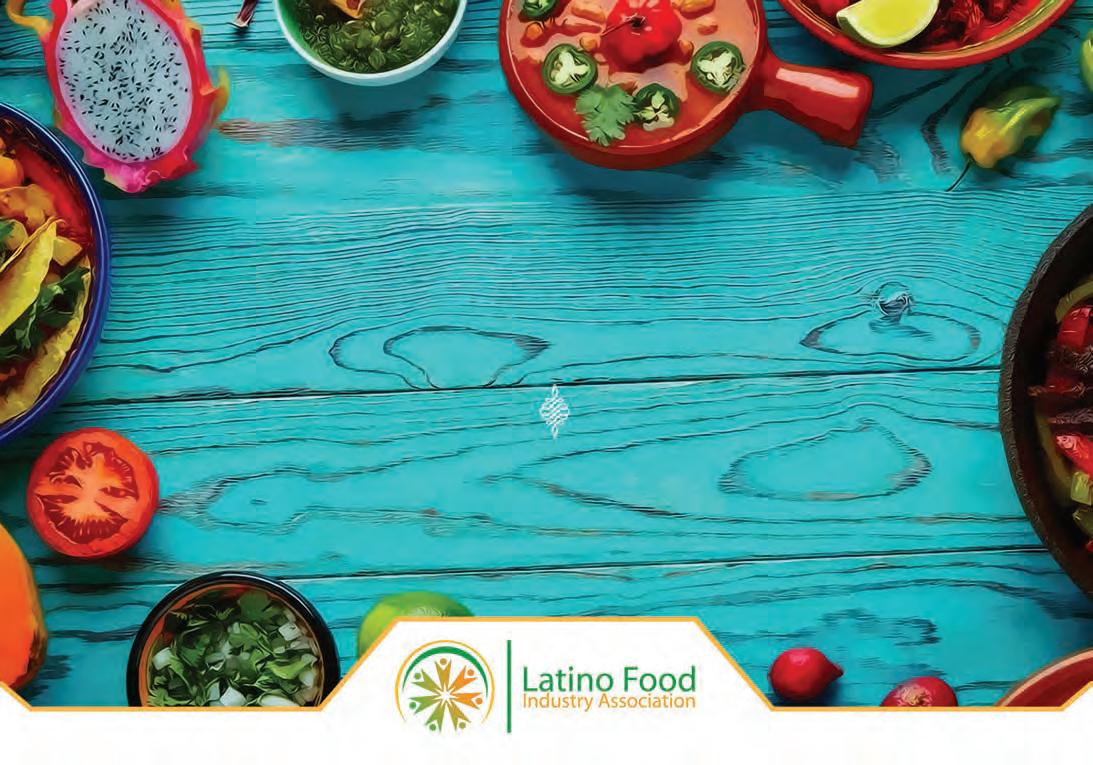

el Restaurante is proud to be a member of LFIA. Learn more and join at latinofoodindustry.org
La Asociación Latina de la industria de alimentos La Asociación Latina de la industria de alimentos (LFIA-Latino Food Industry Association) es una nueva organización diseñada específicamente para usted! Los miembros son propietarios de restaurantes, mercados, proveedores de alimentos, y toda clase de organizacion involucrada en la industria alimentaria. La LFIA Ofrece muchos beneficios para sus miembros. Beneficios que inluyen la asistencia de márketing, servicios tecnológicos y abogacía gubernamental.











